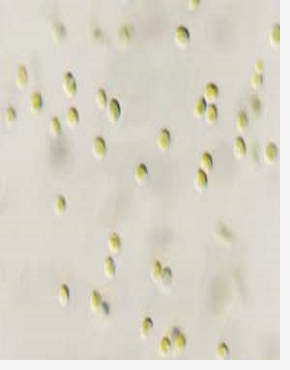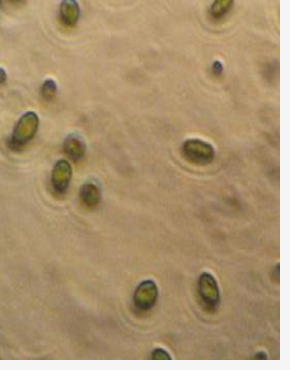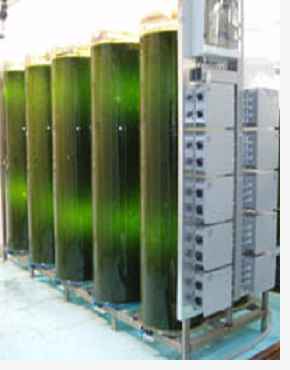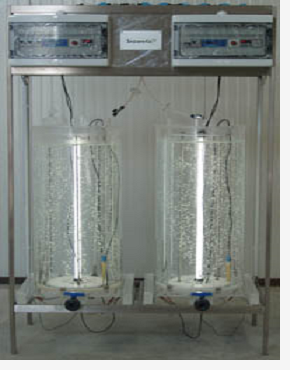Photo Bioreactors
APPLICATIONS IN AQUACULTURE
 Microalgae are utilized in aquaculture for the larval weaning of farmed fish species (gilthead, see bass, sole, tuna) for the enrichment of their diet, constituted of microcrustaceans (e.g. Brine shrimp) and/or zooplancton (e.g. rotifers), and for the farming of bivalval mollusks. In order to enrich the essential larvae for the marine species, the tendency is to stimulate the natural cycle utilizing algal species such as Chlorella salina, Chaetoceros calcitrans, Nannochloropsis oculata, Isochrysis galbana. The tests run by fish farms all over the world and the numerous application in aquaculture verified how diets rich in these algal species bring a considerable enrichment in PUFAs (PolyUnsaturated Fatty Acids), first of all in Brine shrimp and in rotifers, which are the main nutritive elements in the ichthyic food chain. The experimentations conducted by Exenia Group S.r.l. On Nannochloropsis oculata aimed to develop PUFAs production, showed that in the medium utilized for the culture of this micro organism, increased in nitrates, phosphates, with low salinity and temperature, the EPA content is directly increased in the photosynthetic micro organism, up to 3% of the dry weight. In other experiments, parameters such as phosphates, nitrates, salinity, temperature and amount of CO2, in order to understand their influence on the growth of the photosynthetic cells and their EPA production. Along with these studies, which consider Nannochloropsis oculata an important source of EPA and define its potential to increase their PUFAs production acting on factors like growth media, light, temperature and CO2 administration,
Microalgae are utilized in aquaculture for the larval weaning of farmed fish species (gilthead, see bass, sole, tuna) for the enrichment of their diet, constituted of microcrustaceans (e.g. Brine shrimp) and/or zooplancton (e.g. rotifers), and for the farming of bivalval mollusks. In order to enrich the essential larvae for the marine species, the tendency is to stimulate the natural cycle utilizing algal species such as Chlorella salina, Chaetoceros calcitrans, Nannochloropsis oculata, Isochrysis galbana. The tests run by fish farms all over the world and the numerous application in aquaculture verified how diets rich in these algal species bring a considerable enrichment in PUFAs (PolyUnsaturated Fatty Acids), first of all in Brine shrimp and in rotifers, which are the main nutritive elements in the ichthyic food chain. The experimentations conducted by Exenia Group S.r.l. On Nannochloropsis oculata aimed to develop PUFAs production, showed that in the medium utilized for the culture of this micro organism, increased in nitrates, phosphates, with low salinity and temperature, the EPA content is directly increased in the photosynthetic micro organism, up to 3% of the dry weight. In other experiments, parameters such as phosphates, nitrates, salinity, temperature and amount of CO2, in order to understand their influence on the growth of the photosynthetic cells and their EPA production. Along with these studies, which consider Nannochloropsis oculata an important source of EPA and define its potential to increase their PUFAs production acting on factors like growth media, light, temperature and CO2 administration,
It was prosecuted as follows:
- caratterizzazione, attraverso i dati di letteratura, dei principali microrganismi che possono essere fonte di P.U.F.A e risultare così interessanti per il progetto
- individuazione dei metodi di coltivazione individuabili in letteratura: terreni di coltura, tipologia di luce, somministrazione di CO2 , temperatura
- test di coltivazione in laboratorio ed individuazione del miglior metodo di coltivazione che ottimizzi le condizioni operative (composizione dei terreni di coltura, tipologia di luce, quantità di CO2 da insufflare,
- individuazione della miglior configurazione di fotobioreattore
MICROFIL TRAZIONE MICROPLAN
 Biomass production through the Fitoplan system allows to reach extremely high concentrations, beyond 1 billion cells/ml. A standard system composed of a single six cylinders cluster produces every week about 360 l of high concentration algal solution. When the biomass volume needs to be reduced in order to make the storage at 5°C easier. It is advisable to further concentrate 5/10 times the biomass produced. In the example described above, the super-concentration treatment the final biomass volume obtainable would be of 50 l, reducing the need to stock hundreds liters in a refrigerator.
Biomass production through the Fitoplan system allows to reach extremely high concentrations, beyond 1 billion cells/ml. A standard system composed of a single six cylinders cluster produces every week about 360 l of high concentration algal solution. When the biomass volume needs to be reduced in order to make the storage at 5°C easier. It is advisable to further concentrate 5/10 times the biomass produced. In the example described above, the super-concentration treatment the final biomass volume obtainable would be of 50 l, reducing the need to stock hundreds liters in a refrigerator.
This treatment was traditionally performed with plates centrifuges, that have two important limits:
- The plates rotation speed of the centrifuges breaks the cell wall causing the cells death;
- The cost of such machinery is extremely high, at least 35,000 EUR.
These two limits, especially the elevated cost, have limited the super-concentrated biomass production above 7 billions cells/ml.
Today Separeco introduces a new technology based on microfiltration which maintains the same performances without breaking the cell walls, with a drastic decrease in the machinery cost.The Microplan microfiltration system allows to concentrate high amounts of algal biomass, eliminating the water up to 90%.
It is a continuously operating plant, much faster and more efficient than the traditional plates centrifuges. The system, in the single membrane version, is able to concentrate around 150 l per hour, but multi membrane models can increase proportionally the hourly flow rate of the concentrated biomass. The cleaning and regeneration systems is automatized, one night long, allowing the elimination of dead times due to plant cleaning.
Functioning principle:
The plant is constituted by a skid in which all the system components are placed. The stocking reservoirs for the biomass to treat, nor the reservoirs for the treated biomass. The biomass microfiltration membrane is placed inside the skid, in an easily reachable position. The membrane works with the transversal flow filtration method. Such method, compared to the direct flow filtration method of the conventional filters, has the benefit to realize a high filtration degree. The transversal flow filtration is a continuous process in which the feeding flow is parallel (tangential) to the filtration surface of the membrane, generating two exiting flows. A small fraction of the feeding, called permeated or filtrated, separates as a purified liquid through the membrane. The remaining fraction, called held or concentrated, contains the particles not filtered by the membrane. The separation is guided by the pressure gap through the membrane.The feeding parallel flow, combined to the turbulence of the boundary generated by the transversal flow speed, sweeps away the particles and the other materials which otherwise would bulk on the membrane surface. The liquid flows inside the membrane at a very high speed parallel to the membrane surface, keeping it clean.
Advantages:
Membranes offer several advantages. This separation technology can be defined environmentally friendly compared to the other separation techniques. No additives are required, and they offer a much wider temperature range for the process. Therefore filtration assumes a light character, highly selective without phase modifications. The cost for the system are low.
Hints on the microfiltration technique:
Membranes are able to selectively filtrate gases or liquids in solution or mixture, separating the different components. The micropores of the membranes are such to guarantee that some molecules, given their size, are restrained, whereas others are allowed to flow. Each membrane results to be specific thanks to the special molecular structure purposely studied for the components separation.
Membranes filtration is considered a BAT in the BREF IPPC (Best Available Techniques Reference Document) for the food industry because of the reduced impact in terms of hydraulic consumption and wastewater production. The applicable techniques are three, and they differentiate on the basis of the micropores size, hence in their retention capacity: microfiltration, ultrafiltration and inverted osmosis.
Microfiltration:
Low-pressure membrane process in countercurrent for the suspended colloidal particles, having 0.1-10 μm diameter, separation.
It is a strictly physical process, in which particles are kept on the membrane surface. Any particles bigger than the membrane pores diameter cannot pass through it. It is applicable, for example, for fluids sterilization.
Ultrafiltration:
In the ultrafiltration the membranes hold the particles having 0.01-0.1 μm diameter under a pressure of 0.5-10 bar.
It is a suitable method for the concentration alternative to size exclusion chromatography.UF membranes are interesting for biopharmaceutical applications.
The main advantages of ultrafiltration compared to chromatographic techniques are:
- High capacity.
- Easy scale-up.
- Easy cleaning and sanitation of the plants.
Reverse osmosis:
Osmosis acts through a semi-permeable membrane, therefore for two saline solutions having different concentrations water passes trough the less concentrated solution to the more concentrated one, until the equilibrium is reached. Acting with an external work (pressure) on the more concentrated solution, water is forced to pass through the membrane, so a higher concentration is obtained (reverse osmosis, RO). The semi-permeable membrane holds any particles having size bigger than water's. It is a high efficiency technique for the concentration/separation of solute molecules having relatively low molecular weight.
It is not selective, high energy demanding, and quite costly.
SYSTEMS FOR AQUACULTURE
 Along the years Separeco distributed numerous microalgae production plants to utilize in the fish farms producing giltheads. These systems have been optimized for the production of two particular species of microalgae, universally utilized in this field:
Along the years Separeco distributed numerous microalgae production plants to utilize in the fish farms producing giltheads. These systems have been optimized for the production of two particular species of microalgae, universally utilized in this field:
The efficiency of the reactors developed in collaboration with the R&D company Exenia Group from Albignasego (Padova) allowed us to reach in this field productive efficiencies unreachable until short time ago.
The benefits produced by this new cultivation system are:
How many reactors are used to feed my fry?
This question can be answered in two ways:
Rapid Method:
If the production period is annual, it is necessary to be equipped wit h1.2 reactors every 1 million fishes produced.
Accurate Method:
If the desired microalgae concentration in the production ponds is next to 800,000 cells/ml, it is necessary to be equipped with a reactor for each 10,000 liters.
These considerations, translated in the daily operativeness, mean that only 8 liters of concentrated microalgae produced with the Fitoplan are necessary every day in order to feed a 10,000 liters pond, equivalent to 56 g dw.
The cost
The calculated cost of one liter of solution produced with Fitoplan, considering the manpower, the energy, the CO2 and the plant amortization cost, is around 0.5 EUR/l.
At the end of the amortization period the cost is reduced to 0.3 EUR/l.Returning to the previous example, the feeding cost of a 10,000 l pond is 2.4 EUR/day.
Hereunder it is possible to consult the comparative tables for the Nannochloropsis production.
Phytoplan need calculation
SISTEMI BIODISEL
Lorem ipsum dolor sit amet, consectetur adipisicing elit, sed do eiusmod tempor incididunt ut labore et dolore magna aliqua. Ut enim ad minim veniam, quis nostrud exercitation ullamco laboris nisi ut aliquip ex ea commodo consequat. Duis aute irure dolor in reprehenderit in voluptate velit esse cillum dolore eu fugiat nulla pariatur. Excepteur sint occaecat cupidatat non proident, sunt in culpa qui officia deserunt mollit anim id est laborum."
THERMOSTATED RESEARCH SYSTEMS
 Separeco boasts a deep knowledge in the field of reactors for the production of photosynthetic micro organisms biomasses. Our technology is based on the optimal transfer of luminous energy emitted by the bulbs, considered per volume unit. For this reason we utilize annular type reactors, in which the light source is placed. IN particular, we set up a new research system, very compact, that allows to grow termophile micro organisms, absolutely inexistent on the market. Our reactors utilize cold light bulbs, which do not transfer any heat to the culture medium, hence there is no need for a cooling system, unless obviously, the desired temperature is below the environmental one.The main skid measures only 110 cm x 55 cm and contains all the necessary equipment for a good functioning of the plant, precisely:
Separeco boasts a deep knowledge in the field of reactors for the production of photosynthetic micro organisms biomasses. Our technology is based on the optimal transfer of luminous energy emitted by the bulbs, considered per volume unit. For this reason we utilize annular type reactors, in which the light source is placed. IN particular, we set up a new research system, very compact, that allows to grow termophile micro organisms, absolutely inexistent on the market. Our reactors utilize cold light bulbs, which do not transfer any heat to the culture medium, hence there is no need for a cooling system, unless obviously, the desired temperature is below the environmental one.The main skid measures only 110 cm x 55 cm and contains all the necessary equipment for a good functioning of the plant, precisely:
FITOPLAN PHOTO-BIOREACTORS
Productive potential
The FITOPLAN® system resulted to be particularly effective for the cultivation of photosynthetic microalgae such as Nannochloropsis spp., Phaeodactylum spp., Chlorella spp., Tetraselmis spp., Pavlova spp., Isochrysis spp, Thalassiosira spp. And other species, obtaining variable daily productivities, depending on the strain, between 0.3 and 0.5 gl-1d-1. In the case of Nannochloropsis spp. The concentration reached is 1.3-1.5 billions cells per milliliter after a cultivation period of 7-10 solar days (7.6 g/l). Naturally it is necessary to choose an industrial cycle (start-up, growth, collection) to be 4 to 10 days long, and it has to be function of your internal organization (a cycle with collection rotation for the obtainment of a continuous production or with periodic collection for productions having fixed matureness). These choices depends on the expected qualitative and quantitative results and on the needs of your organization.The surface occupied by the productive system and the technological annexes results to be around 20-30 m2 for a medium-large scale system.
Area occupied:
The area occupied by the production system and technological results to be annexed 20/30 - square ca. in the case of a medium / large system.
Energetic consumption:
The photobioreactors energetic consumption for the indoor illumination is 0.5 KW for each one.
Given the reactors particular geometry, it is possible to evaluate the utilization of luminous mixed cycles (artificial/natural lights) so that it is possible to reduce the energetic by 30%. The obtained electrical energy savings are around 60%, as an effect of the minimum volume of illuminated medium, which contains a cells concentration up to 50 times higher than the ones in traditional systems.
Work effort:
The work requested for the system management results to be much lower and, depending on its size and organization, it is lower than the work applied in the traditional systems by 50-80%. Moreover this system allows considerable savings in the nutrients utilization for the alimentary row enrichment, as an effect of the high cells concentration per milliliter, and this concentration achievement is possible thanks to the FITOPLAN® system and the better quality of the final product, the latter determined by more effective controls.
The manufacturer can guarantee the following design and construction characteristics for the plant:
- Process engineering and system design,
- Dimensional calculation of the recipients and the utilized equipments,
- Installation drawings, installation manuals and operational/maintenance manuals,
- Electrical schemes project,
- Specialized manpower for the installation and the start-up.



